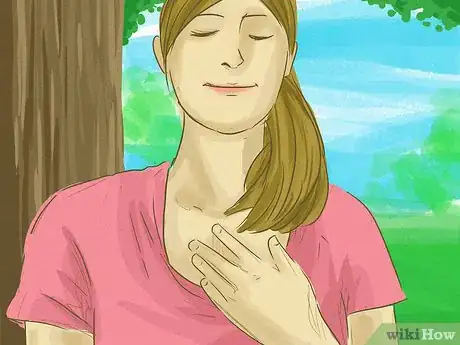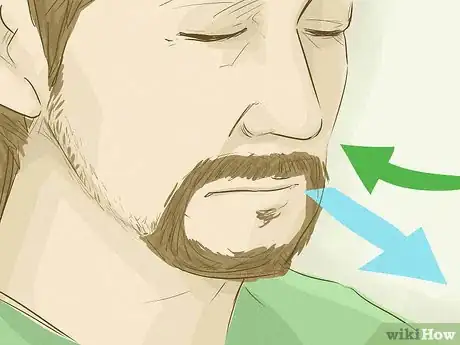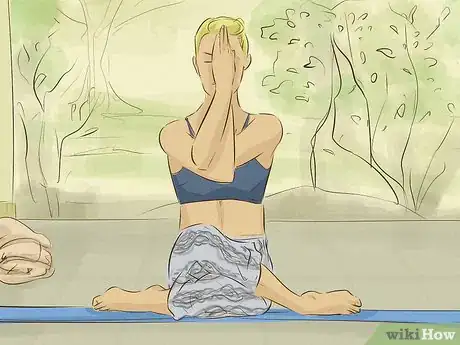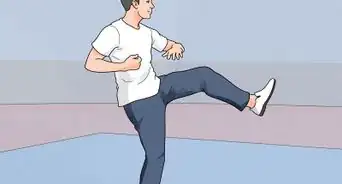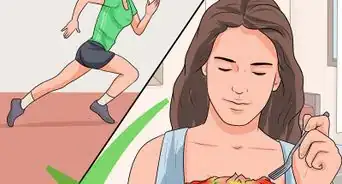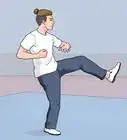This article was co-authored by Susana Jones, C-IAYT and by wikiHow staff writer, Danielle Blinka, MA, MPA. Based in San Diego, Susana Jones is a Yoga Therapist and Educator with 12 years of experience serving groups, individuals and organizations. She is certified with the International Association of Yoga Therapists, registered as an E-RYT 500 with Yoga Alliance and holds a Bachelor’s degree from the University of Colorado. Susana offers therapeutic yoga to private clients through Shakti Urbana and mentors students of the internationally accredited Soul of Yoga. Susana dedicates her work to peaceful living on a healthy planet.
There are 15 references cited in this article, which can be found at the bottom of the page.
This article has been viewed 41,667 times.
Yoga is an ancient practice that can help you relieve stress and keep you energized and focused throughout your day. You don't have to be the most accomplished yogi to use yoga to stay healthy – just grab a mat and commit a few minutes each day to your practice. Over time, you'll notice your muscles are stronger and your body works more smoothly.[1]
Steps
Overcoming Anxiety
-
1Find a comfortable place. Yogic breathing and meditation can help calm your mind and relax your body, especially when you are feeling stressed out. To gain these benefits, find a cool, quiet place with few distractions.[2]
- While it can be relaxing to meditate in a public park, if you are a beginner you may want to be somewhere more private so you can fully relax.
- Start by getting into a comfortable seated position – either cross-legged or in a chair with your feet on the floor.
-
2Start with deep breathing. Deep yogic breathing will help relax and center you. Inhale slowly and deeply through your nose to the depths of your chest, imagining that you are slowly filling your lungs from the bottom to the top.[3]
- When you've inhaled as much as you can, pause for a moment to appreciate the feeling of your lungs being full of air. Then slowly exhale out of your mouth, thinking about releasing the air from your lungs from the top all the way to the bottom.
- Pause again when you've exhaled all the air before beginning an inhale again. Continue this cycle, keeping your mind focused on your breath.
Advertisement -
3Progress to breath of fire. Breath of fire is a powerful breathing technique that will give you energy. Use it especially when you find yourself dragging during the day or losing focus.[4]
- Start with long, deep breathing. With breath of fire, rather than pausing and slowly exhaling, you will push the air out of your lungs quickly and forcefully out your mouth. As soon as most of the air in your lungs is gone, immediately inhale as much air as you can forcefully.
- Engage your abdominals to push the air out when you exhale. With every breath cycle, try to inhale and exhale a little faster.
-
4Ground yourself with alternate nostril breathing. After doing some deep yogic breathing to start, place your right thumb over your right nostril and inhale deeply through your left nostril. When you've inhaled all you can, use your fourth finger to close off your left nostril and lift your thumb so that you can exhale out of your right nostril. Next, inhale through your right nostril, then cover it with your thumb. Lift your fourth finger so you can exhale out of your left nostril.[5]
- Focus your mind on your breath, continuing this cycle for three to five minutes.
-
5Try a guided meditation. You can take a guided meditation class, or look for free guided meditation recordings online. Recordings also may include relaxing music or other sound effects that will aid in relaxation.[6]
- Close your eyes and focus on the voice, visualizing the images the voice tells you to in your mind. Guided meditations give you something to focus on, which can be useful when you're just starting to meditate and don't have practice clearing your mind.
- Establish a regular practice of meditating for 5 to 10 minutes a day, either in the morning or in the evening before you go to bed. Over time you'll notice a difference in your anxiety levels and your mental focus and clarity.
-
6Practice mindfulness in everyday life. When you focus on your breath while meditating, you are being mindful of your breath. You can expand this mindfulness to other areas of your life. Actually focus on the things that you do throughout the day, rather than going through tasks on auto pilot while your mind is elsewhere.[7]
- When you act consciously and mindfully, you'll see an impact in your health and well-being. For example, if you eat mindfully, you may find that you lose weight and adopt more healthy eating habits.
-
7Use equal breathing before sleep. Equal breathing is kind of like counting sheep, and allows you to focus on your breath to calm your body and stop your mind from racing at the end of a long and hectic day.[8]
- Start by inhaling deeply as you count to four. Then immediately exhale for a count of four. Continue the cycle, focusing on the inhale and exhale being completely equal.
- With practice, you can lengthen your count to five, six, or even eight.
Strengthening Your Body
-
1Use planks and side planks to build a strong core. You may be familiar with plank exercises from other workouts. The same pose exists in yoga, with more focus on maintaining a deep breath to strengthen your abdominal muscles.[9]
- For a full plank pose, support yourself over the floor on your hands and toes so that your body is a straight line more or less parallel with the floor. Make sure your wrists are directly under your shoulders, and cup your palms to place less stress on the joint. If you’re struggling to hold yourself up, modify the plank by resting on your forearms instead of your hands.
- For a side plank, start in a full plank position. To do a right side plank, shift your weight to the right and support yourself on your right hand, with your arm still extended toward the floor. Then, move your left leg and foot on top of your right leg and foot. Next, raise your left arm up toward the sky, perpendicular to your body. If you’re struggling to hold yourself up, modify the plank so that you’re resting on your forearm. To do a left side plank, shift to the left side and stack your right leg and foot on top of your left.
-
2Try boat and low boat for lower abdominals and hips. Both boat and low boat require every muscle in your core and hips to be engaged. Get into boat pose by sitting on your mat with your knees bent so that your feet are flat on the floor in front of you.[10]
- Extend your arms out in front of you, palms just to the side of either knee. Lean back so that your torso is at about a 45-degree angle from the floor, then lift your feet to straighten your legs. Try to angle your legs upward at the same angle as your torso.
- To progress into low boat, simply lower your torso until your lower back is flat on the floor. Lower your legs at the same angle at the same time, keeping your core engaged. Don't forget to maintain your deep breath.
- Hold these poses for 3 to 5 breath cycles.
-
3Work your arms and legs with chair pose. Come to a standing position with your arms loosely to your sides to get into chair pose. Slide your feet together so that your big toes are touching, heels slightly apart. Focus on your breath.[11]
- As you inhale, extend your arms straight up toward the ceiling. You can keep them apart with palms facing each other, or bring your palms together above your head.
- On an exhale, bend your knees and lower your hips to the floor. Try to keep your knees from projecting out over your toes. They will move forward a little, but keep your shins as perpendicular to the floor as possible.
- Hold the pose for 5 to 10 breath cycles, breathing deeply. Make sure your shoulders are rolled back and not hunched. Squeeze a yoga block or a book between your knees to further build your thigh muscles.
-
4Progress through a warrior flow. Moving through the three main warrior poses provides a whole body workout, particularly strengthening your legs, back, and shoulders. From standing, step one foot back into a high lunge position to start.[12]
- The toes of your front foot should be pointed forward, with your knee at a right angle directly over your ankle. Point the toes of your back foot slightly to the side, so that your back foot is at a 45 degree angle. Keep your hips facing forward. Raise your arms straight overhead into Warrior I.
- From Warrior I, drop your arms down to shoulder level and extend them out parallel to the floor. Slide your back foot to the side, so that it’s parallel to the back of your mat and perpendicular to your front foot. Twist and open your shoulders into Warrior II with your arms directly over your legs.
- From Warrior II, turn to face forward, bringing both arms out directly in front of you. Raise up onto your front leg, standing firmly on your foot. Slowly lift your back leg up behind you as you hinge forward from your hips. Firm up your standing leg to maintain your balance in Warrior III.
- Make sure to repeat the entire sequence on the other side.
-
5Strengthen your spine with downward facing dog. Downward facing dog is a classic yoga pose that also provides strengthening benefits for your entire body. To get into downward facing dog, start on your hands and knees on the floor. Make sure your knees are directly under your hips, your wrists directly under your shoulders.[13]
- On an exhale, straighten your legs, lifting your hips up towards the ceiling. Roll over your feet onto your toes, stretching your heels down towards the floor. Your arms should be extended straight towards the floor. Roll your shoulders back so that your shoulder blades run along the sides of your spine.
- Stay in downward dog for 5 to 10 deep breaths, pulling down through your heels and up through your shoulders to maintain weight balance and distribution. Relax your neck and allow your head to lower.
-
6Relax in child's pose. Child's pose is a common way to end any yoga routine, because it allows your body to relax and allows you to return your focus to your breath. Child's pose also provides strengthening and lengthening for your spine and back muscles.[14]
- Lower onto all fours from downward dog, then continue to drive your hips back until you are resting on your heels. You can draw your knees together or keep them spread.
- Hinge forward from the hips as you slide your hands forward, folding over your legs to the floor. Rest your forehead on the floor if it's comfortable. If you don’t want to rest your head on the floor, layer your forearms in front of you, then rest your head on your arms. As another alternative, you can rest your head on a yoga block.
- Make sure you don’t let your head dangle, as this can cause neck injury.
Improving Organ Function
-
1Warm up with the cat/cow stretch. Moving between the cat and cow poses is a good way to loosen up your spine and warm up your entire body as you start a yoga routine. It also stimulates your internal organs and increases circulation to your torso.[15]
- Start on all fours with your knees directly under your hips and your wrists in line with your shoulders. Avoid hyperextension in the elbows; it is better to keep a very soft bend in them.[16]
- On an inhale, arch your back, pressing your tailbone into the air. Drop your shoulders down your back and cast your gaze forward. This is the cow pose.
- As you exhale, round your back, curling your shoulders downward. Drop your gaze down to the floor. This is the cat pose.
- Continue going back and forth between cat and cow, with a breath between each movement, for 10 to 20 deep breath cycles.
-
2Relieve congestion with a forearm wheel. The forearm wheel helps open your chest to help clear your lungs, and also helps activate your metabolism. Prep for the forearm roll by laying on your back on the floor.[17]
- Bend your knees so your feet are flat on the floor, and slowly press your hips up into a backbend. Keep lifting until you can place the crown of your head gently on the floor, then place your forearms flat on the floor on either side of your head.
- Hold the position for 5 to 10 breath cycles, breathing deeply, then slowly lower your hips to the floor and return to a reclined position.
-
3Stimulate your liver and kidneys with a seated forward fold. The seated forward fold stimulates your lower internal organs to improve digestion as well as providing some relief for high blood pressure, sinusitis, and sexual disfunction.[18]
- Come to a comfortable seat on the floor. You may want to support yourself with a folded blanket so that you are sitting with correct posture. Extend your legs out in front of you, flexing your feet and pressing through your heels actively.
- As you inhale, hinge forward from your hips, keeping your back long, and fold over the tops of your legs. Grab the sides of your feet with your hands. If you can't fold that far, you can grab your legs instead, or use a yoga strap to maintain the correct position.
- Hold the pose for 10 to 10 deep breath cycles. With each inhale, think about lifting and lengthening your spine. With each exhale, try to sink a little deeper into the fold.
-
4Use the wind-relieving pose to improve digestion. The wind-relieving pose, as the name implies, can help relieve gas, bloating, and indigestion. You may want to make sure you have some privacy before you do this pose.[19]
- Prepare for this pose by lying on your back on the floor. Keep your feet together and rest your arms by your side. As you exhale, grasp your right knee with your hand and press it toward your chest. Hold the pose as you take several deep breaths. Then release and repeat with the other leg.
- You also can do this pose raising both legs at the same time. Press them to your chest. You can rock up and down or roll around to stimulate your spine and increase relaxation.
-
5Boost your metabolism with raised legs pose. The raised leg pose can stimulate your abdominal organs, particularly if you remember to engage the muscles in your core while holding this pose.
- Lie on your back on the floor with your legs extended out and pressed together. You can rest your arms at your sides, or place them under your buttocks, palms down, to help support your lower back.
- On an inhale, slowly raise your feet until your legs are at a 90-degree angle from your body. Lower your legs to the floor as you exhale, but don't let them fall all the way to the ground. Remember to engage your core.
- Repeat the cycle for 5 to 10 breath cycles.
-
6Rest in corpse pose. The corpse pose is the ultimate yoga pose for healing and relaxation. This pose helps increase your blood flow to all your organs. To get into corpse pose, simply recline on your back and extend your arms to your sides, palms up.[20]
- Breathe deeply, relaxing all your muscles. It can help to think about your body sinking or melting into the floor. Press your lower back firmly to the floor and focus on your breath. You can stay in corpse pose as long as you feel comfortable.
References
- ↑ https://www.yogajournal.com/lifestyle/count-yoga-38-ways-yoga-keeps-fit
- ↑ https://greatist.com/happiness/breathing-exercises-relax
- ↑ http://www.kundaliniyoga.org/Pranayama
- ↑ http://www.kundaliniyoga.org/Pranayama
- ↑ http://www.chopra.com/articles/breathing-for-life-the-mind-body-healing-benefits-of-pranayama
- ↑ https://greatist.com/happiness/breathing-exercises-relax
- ↑ http://www.health.harvard.edu/staying-healthy/yoga-benefits-beyond-the-mat
- ↑ https://greatist.com/happiness/breathing-exercises-relax
- ↑ http://www.shape.com/fitness/workouts/6-yoga-poses-rock-solid-core
- ↑ http://www.shape.com/fitness/workouts/6-yoga-poses-rock-solid-core
- ↑ https://www.yogajournal.com/poses/chair-pose
- ↑ http://lotsofyoga.com/poses/warrior-pose/warrior-pose-virabhadrasana
- ↑ https://www.yogajournal.com/poses/downward-facing-dog
- ↑ http://www.chopra.com/articles/20-minute-yoga-sequence-to-open-yourself-to-the-new-year
- ↑ http://www.chopra.com/articles/20-minute-yoga-sequence-to-open-yourself-to-the-new-year
- ↑ Susana Jones, C-IAYT. Certified Yoga Therapist & Educator. Expert Interview. 4 March 2020.
- ↑ http://www.chopra.com/articles/7-yoga-poses-to-detox-your-body
- ↑ https://www.yogajournal.com/poses/seated-forward-bend
- ↑ https://www.artofliving.org/us-en/yoga/yoga-poses/wind-relieving-pose
- ↑ https://www.doyouyoga.com/5-yoga-postures-to-improve-digestion/
About This Article
You can use yoga to improve both your physical and mental health. If you want to get physically fit with yoga, try strength-building poses such as the plank, the boat, or the chair pose. Or, get a workout with a yoga flow, in which you move smoothly through a series of poses that target different parts of your body. For stress relief, focus on calming practices like guided meditation, deep breathing, or alternate nostril breathing. Sign up for a yoga class for guidance if you’re new to yoga or want to improve your practice. For expert advice on how to improve your organ function with yoga, read on!
